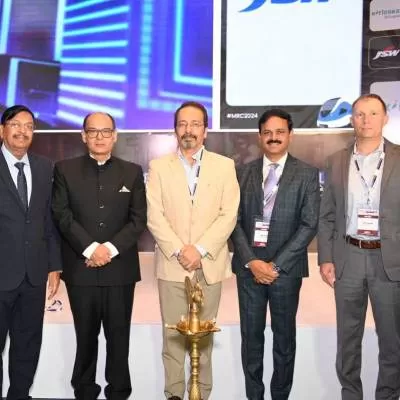- Home
- Infrastructure Energy
- POWER & RENEWABLE ENERGY
- Awareness of green initiatives is restricted to the niche sector in India
Awareness of green initiatives is restricted to the niche sector in India
The National Conference on Green Design, organised by ADaRSH (Association for Development and Research of Sustainable Habitats) along with The Energy and Resources Institute (TERI) and Ministry of New and Renewable Energy (MNRE) in New Delhi from February 14-15, 2013, reinstated the importance of green buildings, propelling new initiatives towards a greener India. Mili Majumdar, Director-Sustainable Habitat, ADaRSH, elaborates upon the conference, the green movement in India and the other initiatives of TERI in conversation with SHUBHANGI BIDWE.
What were the key takeaways from the conference?
One of the most important objectives achieved included the willingness of the top government officials to boost green initiatives in our country. The President himself conferred the GRIHA Awards, which reinstated the importance of adopting green building options in India. The conference structure also facilitated lifestyle options to make buildings greener; including those that can be implemented even by a common person. Celebrities such as actor Gul Panag elaborated on the methods to make their homes greener at the conference. Similarly, Ambarish Oberoi, who has built a green house for himself, elaborated on the construction techniques that boosted people's confidence in these initiatives. Speakers from countries such as Africa and the UK told us about their green initiatives and research conducted on national and regional levels. Attended by manufacturers, architects, government and students, the event launched greenhouse applications for mobile and android phones.
We also organised documentary and photography competitions for students at the event.
Is there a change in perception towards adopting green buildings?
There is definitely a positive change but it is currently restricted to the niche sector. To penetrate the masses, it requires more awareness, and availability of more services and materials.
On what parameters were the winners selected for the GRIHA Awards? Is there any path-breaking technology that came to light in any of these winning projects?
The GRIHA rating has a standard framework with 34 criteria. Depending on how each building fares with respect to each criterion, they are given points that are added to make the ratings. More than technology, there were path-breaking concepts. For instance, the Pimpri Chinchwad New Town Development Authority office building, designed for solar passiveness, is powered fully through renewable energy. Similarly, the ZED Earth building uses innovative technologies such as a green roof, cavity constructions and green interior materials. Infosys adopts an innovative radiant cooling technology that reduces energy consumption. The projects of ITC Grand Chola have an innovative air-conditioning system and complete wind farms to manage the energy load. We also launched a new rating system at this conference known as GRIHA for large developments (LD) ratings.
What parameters are required to qualify for this new rating?
These ratings evaluate the net impact of the habitat on a piece of land. We will also consider the land's carrying capacity and its impact on urban heat island and green covers. These ratings will apply to large projects such as townships, SEZ, large housing projects, campuses, educational institutes, etc.
Recently TERI and Orissa Tourism Development Corporation (OTDC) signed an MoU. Please elaborate on this.
As OTDC is involved in the development of new hotels and resorts, this MoU will ensure the implementation of eco-friendly measures to make them green besides retrofitting the existing ones. Through this, sustainable tourist circuits involving application of GRIHA parameters at different levels will be developed besides audits of existing facilities, training, capacity building, and empowering people to adopt these measures.
What kind of support is the state government lending you for this initiative?
The initiative has received a separate budgetary and resource allocation from the government. But the details of this support are not yet indicated. However, this MoU will increase the number of GRIHA-compliant destinations in the country and consolidate the green movement across India.
To give your feedback on this interview, write in at feedback@ASAPPmedia.com
Mili Majumdar, Director-Sustainable Habitat, ADaRSH The National Conference on Green Design, organised by ADaRSH (Association for Development and Research of Sustainable Habitats) along with The Energy and Resources Institute (TERI) and Ministry of New and Renewable Energy (MNRE) in New Delhi from February 14-15, 2013, reinstated the importance of green buildings, propelling new initiatives towards a greener India. Mili Majumdar, Director-Sustainable Habitat, ADaRSH, elaborates upon the conference, the green movement in India and the other initiatives of TERI in conversation with SHUBHANGI BIDWE. What were the key takeaways from the conference? One of the most important objectives achieved included the willingness of the top government officials to boost green initiatives in our country. The President himself conferred the GRIHA Awards, which reinstated the importance of adopting green building options in India. The conference structure also facilitated lifestyle options to make buildings greener; including those that can be implemented even by a common person. Celebrities such as actor Gul Panag elaborated on the methods to make their homes greener at the conference. Similarly, Ambarish Oberoi, who has built a green house for himself, elaborated on the construction techniques that boosted people's confidence in these initiatives. Speakers from countries such as Africa and the UK told us about their green initiatives and research conducted on national and regional levels. Attended by manufacturers, architects, government and students, the event launched greenhouse applications for mobile and android phones. We also organised documentary and photography competitions for students at the event. Is there a change in perception towards adopting green buildings? There is definitely a positive change but it is currently restricted to the niche sector. To penetrate the masses, it requires more awareness, and availability of more services and materials. On what parameters were the winners selected for the GRIHA Awards? Is there any path-breaking technology that came to light in any of these winning projects? The GRIHA rating has a standard framework with 34 criteria. Depending on how each building fares with respect to each criterion, they are given points that are added to make the ratings. More than technology, there were path-breaking concepts. For instance, the Pimpri Chinchwad New Town Development Authority office building, designed for solar passiveness, is powered fully through renewable energy. Similarly, the ZED Earth building uses innovative technologies such as a green roof, cavity constructions and green interior materials. Infosys adopts an innovative radiant cooling technology that reduces energy consumption. The projects of ITC Grand Chola have an innovative air-conditioning system and complete wind farms to manage the energy load. We also launched a new rating system at this conference known as GRIHA for large developments (LD) ratings. What parameters are required to qualify for this new rating? These ratings evaluate the net impact of the habitat on a piece of land. We will also consider the land's carrying capacity and its impact on urban heat island and green covers. These ratings will apply to large projects such as townships, SEZ, large housing projects, campuses, educational institutes, etc. Recently TERI and Orissa Tourism Development Corporation (OTDC) signed an MoU. Please elaborate on this. As OTDC is involved in the development of new hotels and resorts, this MoU will ensure the implementation of eco-friendly measures to make them green besides retrofitting the existing ones. Through this, sustainable tourist circuits involving application of GRIHA parameters at different levels will be developed besides audits of existing facilities, training, capacity building, and empowering people to adopt these measures. What kind of support is the state government lending you for this initiative? The initiative has received a separate budgetary and resource allocation from the government. But the details of this support are not yet indicated. However, this MoU will increase the number of GRIHA-compliant destinations in the country and consolidate the green movement across India. To give your feedback on this interview, write in at feedback@ASAPPmedia.com
























